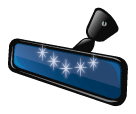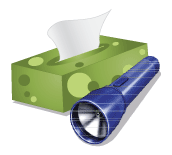 |
||||||
|
|
Number
337
|
January
2008
|
||||
|
P.O. Box 189, Moffett Field, CA 94035-0189 |
||||||
|
|
||||||
 |
||||||
|
|
Number
337
|
January
2008
|
||||
|
P.O. Box 189, Moffett Field, CA 94035-0189 |
||||||
|
|
||||||

Incidents from ASRS Files
In recent months the Editor has been collecting reports from general aviation and air carrier pilots that describe incidents outside the realm of what is routinely reported to the ASRS program. Some of the lessons to be learned from these reports are that vigilance, standard operating procedures, and training can safely resolve even the most off-beat and hazardous situations. To kick off the New Year, we offer these glimpses into unusual events of the year just past.

Downed by the Dump
Sunglasses, lack of oxygen, and confusion all played a part in a Cessna 441 pilot’s pressurization emergency.
While cruising at 26,000 feet I became ill (or so I thought). In fact, the aircraft was not maintaining cabin pressure. I was flying southwest into a very bright sun. I put on dark sunglasses for eye comfort. The cabin altitude [warning] light was on, but I could not see it. I keep a small first aid kit behind the seat, [and] when I turned to get it I saw the O2 mask in the cabin had deployed. After some confusion, I put on my O2 mask and asked for lower. The controller did a great job when I told him I needed to get down.
After my head cleared up some, I leveled off and discovered I had pulled the cabin dump valve with my pant leg. I know it sounds impossible, but it happened.
Disappearing Prop
An Aeronca pilot’s preoccupation with cowling removal during maintenance contributed to a nasty surprise on a subsequent test flight.
The Chief had compression problems on one cylinder and the cowl had to be removed for maintenance. The prop must be removed to take the nose bowl off a Chief. After engine repair, the cowl was reinstalled and the prop placed on the tapered shaft to check for rubbing. The spinner...was installed because it is the first thing to rub if the cowl is not on perfectly. It rubbed, so the cowl had to be loosened and retightened until everything had sufficient clearance. The engine was test run and the airplane appeared ready for flight, even though the prop, which was only placed on the shaft to test for clearance, had not been tightened or safetied. The spinner prevented this from being noticed before flight. The engine tested fine in the pre-takeoff check, and the flight proceeded normally for about 30 minutes until a knocking sound was noticed. Power was reduced, and the prop departed the airplane and landed, as best we can tell, in a woods north of the airport...The Chief glided back to the airport and landed with no problems and no damage....
The cause was distraction with the cowl and resultant oversight of the prop’s improper attachment. The problems that could result from not securely attaching the prop before flight are obvious...I know it will not happen again with anything I am flying.
Publication Interference
An orderly cockpit – with publications and charts securely stowed – can prevent the type of incident reported by this Piper Comanche pilot. The pilot had been practicing holding procedures with an instructor, and had been cleared to land by Tower.
...I completed my pre-landing (GUMP) procedure: fuel selector – check. Boost pump – on. Gear switch – down. Mixture – full rich. Prop – in high (rpm). I lined up on runway...At the flare on final, loud noises were heard as the aircraft slid to a stop. After the aircraft stopped, I confirmed that the landing gear switch was in fact down. I then found a set of terminal procedure publications wedged between the landing gear extension handle and the floor. Later inspection found the landing gear circuit breaker had been tripped.
 Lights in the Mirror
Lights in the Mirror
A corporate flight crew on a night-time approach to a non-Towered airport fell victim to “an eerie coincidence.”
...We were cleared for a visual approach to Runway 4. The Tower had closed...The airport beacon and PAPI lights were on, but there were no runway lights....I asked the PNF [Pilot Not Flying] to click on the lights using the local Tower frequency and the lights came up full bright on all runways. At the same time, the airport safety vehicle was making a runway and light inspection and he clicked on the lights at the same time as we had, [and] made a local announcement that he was going to be on the runways. We never heard this or subsequent announcements. With the runway lights on, we proceeded to complete our checklists and land on Runway 4. We did not see the vehicle lights or beacon for the glare of the runway lights on high. We landed behind the vehicle. He saw our landing lights in his mirror and thankfully cleared the runway. It was an eerie coincidence that we both clicked on the lights at the same time, thinking each had been responsible for the action. My only thought with regard to the lack of communication with the truck was that we must have misdialed the local Tower (advisory) frequency, and while we thought we were in communication, we were not. Since the lights came up, we were lulled into thinking all was as it should be...Possible mitigation: Local ground traffic monitoring Center frequency to alert truck to presence of air traffic. Double-check frequency selection by aircraft to insure communication.
 An Artful Aroma
An Artful Aroma
For an MD-83 flight crew, fumes in the cockpit led to the discovery of an unexpected source.
Level at 33,000 feet...a strong odor similar to paint thinner was detected by both pilots. Cockpit crew initiated a fume checklist. After securing mask and goggles, cockpit crew established communications with flight attendants. The number one flight attendant reported that he also smelled a strong odor and a flight attendant in the aft of the aircraft also reported an odor. Since we were not able to determine the source of the strong odor, and considering that all of the flight crew reported noticing the smell, the flight crew determined that an emergency should be declared, followed by a divert to ZZZ. After declaring the emergency, ATC cleared the flight to turn 180 degrees for vectors toward ZZZ. As the aircraft was in the turn, the number one flight attendant called the cockpit and informed the crew that the source of the fume-like odor was identified. Apparently, two children sitting in First Class had just begun to color with ink markers. The flight attendant reported, without a doubt, that the smell was coming from the ink being applied to the paper. This was verified by the other flight attendants working the flight, as well as by a pilot in uniform commuting to work. The number one flight attendant reported that the marker is printed with a warning to avoid use of the marker at high altitudes, or in confined spaces....
ATC was then informed that we discovered the source of the unusual odor, and that the situation was now safe and under control. We rescinded the emergency declaration and requested vectors to continue the flight on to our destination. We landed on time, without incident.
Tissue's the Issue
A CRJ700 Captain reported jammed rudder pedals during a takeoff.
While taking off...and at about 50-60 knots, the left rudder jammed and I rejected the takeoff. We made a full stop prior to crossing Runway 23. We then cleared the runways and returned to the ramp to troubleshoot the problem. After we were clear of the runway, I saw a small tissue box under the rudder pedal. This box apparently was already forward of the rudder pedals out of sight when we took over the aircraft. When takeoff power was applied, the tissue box slid back under my foot and rudder pedals causing the rudder to jam. Directional control was difficult but maintained during the rejected takeoff maneuver.
This was our first flight in this aircraft for the trip. Make sure all crews ensure the floor around the pilots seats are clear and that no  foreign objects can slide forward on landing, jamming the rudders.
foreign objects can slide forward on landing, jamming the rudders.
Tissue boxes, flashlights, water bottles, and manuals have all managed to interfere with rudder travel. Usually a visual preflight and a flight control check will detect these objects prior to takeoff. Flight crews should make sure that items that go missing during flight are located prior to turning the aircraft over to the next crew.
It's All in the 9's
A B757 Captain described a startling load planning error.
Cockpit Crasher
It’s up to the flight crew on a ferry flight to ensure that the cabin is secure. Here’s a B737 First Officer’s graphic description of what can happen when that duty is neglected.
...My Captain and I...began preparations for our [ferry] flight. I performed a walkaround inspection then went back to the cockpit to perform the rest of my preflight duties. The aircraft had already been de-catered...and our service rep and another service staff member were on board finishing cleaning. After the cleaning was completed, our rep advised us that all services were completed...My Captain and I performed our normal cockpit duties and departed. We left the cockpit door open. The flight was uneventful...The aircraft touched down smoothly, in the touchdown zone. I applied reverse thrust upon touchdown, then quickly began reducing toward idle. The rate of deceleration was very gradual. At 80 knots, the Captain took control of the aircraft with reverse at idle, and Autobrakes disengaged. At this point a catering cart entered the cockpit at an extremely high velocity and impacted the center console, simultaneously striking me in the left arm. The cart had temporarily departed the floor and came over the top of the center console. Liquid was dispersed all over the cockpit and we smelled something that appeared to be burning. The Captain maintained control of the aircraft and exited the runway at our assigned taxiway. The burning smell quickly went away. The Captain stopped the aircraft, set the parking brake, and we assessed the damage. The panel lighting on the center console was inoperative and the structure of the console was bent slightly. The cart also had major structural damage. There was nothing affecting our safe progression to the gate, so we elected to continue to parking. Once at the gate, we realized that there was further structural damage to the center console, as well as minor damage to 2 cabin seats.
We concluded that the cart had traveled forward from its housing in the aft galley. This event could have been prevented if we had inspected the galleys after the flight attendants and caterers departed the aircraft. It also could have been prevented if we had secured the flight deck door prior to departure.
| ASRS Alerts Issued in November 2007 | |
|---|---|
| Subject
of Alert |
No. of Alerts |
| Aircraft or aircraft equipment |
11 |
| Airport facility or procedure |
7 |
| ATC procedure or equipment |
7 |
| Chart, publication, or nav database |
1 |
Company policy |
1 |
| TOTAL |
27 |
| November 2007 Report Intake |
|
|---|---|
| Air Carrier/Air Taxi Pilots | 2,709 |
| General Aviation Pilots | 917 |
| Controllers | 102 |
| Cabin/Mechanics/Military/Other | 215 |
| TOTAL | 3,943 |